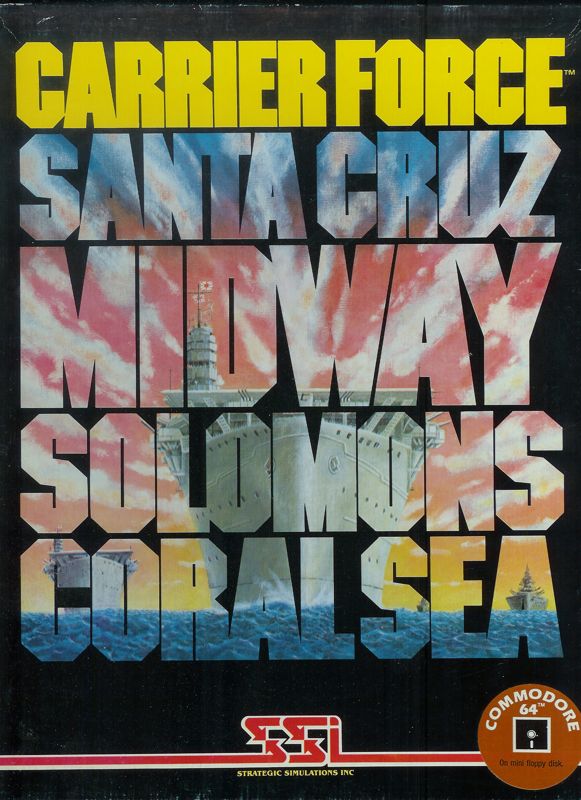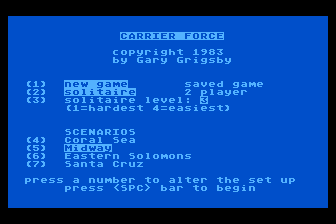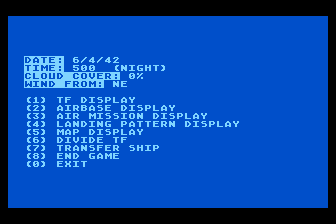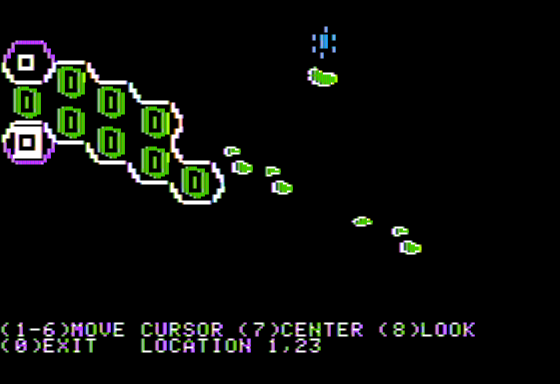Retro Replay Review
Gameplay
Carrier Force plunges you into the heart of carrier warfare in the Pacific theater of 1942, offering a deeply strategic experience that unfolds over four historically significant scenarios: Midway, Coral Sea, the Eastern Solomons, and the Santa Cruz Islands. Each scenario spans multiple game turns, with each turn representing one hour of intense naval and air combat. The emphasis on operational level decision-making means you’re not just sending planes to attack; you’re coordinating reconnaissance, managing fuel and ammo reserves, and timing your strikes to catch the enemy off guard. Every decision carries weight, and the risk–reward balance keeps you on edge throughout the full 3 to 10 hour playing session.
One of the strongest features of Carrier Force is its automation of administrative tasks. Rather than get bogged down in record-keeping, you issue orders and the computer handles movement calculations, damage assessments, and logistics. This allows you to maintain a clear focus on big-picture strategy—where to position your carriers, when to launch air strikes, and how to react to enemy movements. The AI opponent is competent, particularly in solitaire mode where it controls the Japanese forces, adapting to your tactics and forcing you to think several moves ahead.
For those who prefer face-to-face competition, the two-player mode delivers head-to-head tension as you and an opponent jockey for control of the vital sea lanes. The sequential turn structure keeps both players engaged, since operational plans can be adjusted in real time to unfolding events. Whether coordinating a multi-wave torpedo bomber attack or executing a dawn strafing run on enemy cruisers, every action is palpable and impactful.
The victory point system adds an extra layer of strategic depth. At the end of each scenario, American points and Japanese points are tallied, then compared against a victory table to determine the level of success or defeat. This not only reinforces historical outcomes—such as the tactical Japanese victories at Santa Cruz and Eastern Solomons versus the strategic American triumph at Midway—but also provides clear feedback on your performance, giving you a strong incentive to replay scenarios and refine your tactics.
Graphics
Carrier Force’s visual presentation reflects its era, favoring function over flash. The core interface consists of a detailed hex-grid map of the Pacific battle zone, with counters representing carriers, battleships, cruisers, destroyers, and squadrons of aircraft. Each counter is clearly labeled with unit type, strike strength, and defensive values, making it easy to assess your forces at a glance. While the graphics may appear dated by modern standards, the clarity of iconography ensures that you spend your time planning maneuvers rather than deciphering visuals.
The flight and combat sequences are depicted through simple but effective overlays that show attack arcs and ranges. When you launch a squadron of dive bombers or torpedo planes, you’ll see projected flight paths and engagement zones, helping you visualize the tactical picture. Explosion and damage markers animate briefly on the map to indicate hits, creating moments of excitement when a well-timed strike cripples an enemy carrier or knocks out a flight deck.
One of the more impressive aspects is the attention to detail in unit representation. Every major warship and aircraft model from the period is accounted for, from the USS Yorktown and IJN Soryu carriers to the F4F Wildcats and A6M Zeros. Though rendered in simple pixel art, these units are distinguishable by shape and color, immersing you in the historical hardware of 1942. It’s a testament to the designers’ commitment to authenticity, even if the aesthetic leans toward functionality rather than cinematic flair.
Customizable display options let you toggle overlays for range rings, fuel gauges, and hidden movement zones, tailoring the interface to your preferred level of information. While hardcore wargamers will appreciate the high level of data transparency, newcomers can simplify the display to focus on the essentials, smoothing the learning curve for players less familiar with traditional hex-based naval simulations.
Story
Carrier Force doesn’t feature a scripted narrative with cutscenes or character arcs—instead, it weaves history into dynamic, scenario-driven campaigns. Each of the four scenarios is a living vignette of the pivotal carrier battles that shaped the course of World War II in the Pacific. From the desperate hunt for Japanese carriers at Midway to the fierce air duels over the Solomon Islands, the game captures the ebb and flow of naval warfare with remarkable fidelity.
The sense of story emerges from your own decisions and their consequences. Will you launch a risky dawn raid to catch the enemy fleet refueling and rearming, or hold back your planes for a coordinated strike later in the day? As you lose ships and aircraft, you’ll feel the mounting pressure of dwindling resources, mirroring the real-world challenges faced by fleet admirals in 1942. It’s not just about winning or losing; it’s about recreating the tension and uncertainty of naval command under fire.
Historical events such as reconnaissance successes or failures, sudden weather changes, and lucky torpedo hits can pivot the narrative in unexpected directions. A dangerous fog bank might shield one fleet from detection, while a lucky dive-bombing run could sink a battleship and swing momentum in your favor. These emergent stories keep each playthrough fresh, encouraging you to explore “what-if” strategies that diverge from actual history.
Although there’s no protagonist or scripted dialogue, the game’s emphasis on authentic detail—down to individual aircraft fuel capacities and ship damage thresholds—grounds you in the historical moment. The end result is a sandbox of naval history, where you become the storyteller by testing your strategic mettle against the tides of war.
Overall Experience
Carrier Force is tailored for dedicated wargamers who appreciate deep, methodical simulations. The learning curve is steep, but the payoff is a richly detailed operational experience that few games of its era can match. If you relish poring over reconnaissance reports, plotting multi-phase attacks, and tweaking carrier task forces for maximum combat readiness, Carrier Force will hold your attention for hours on end.
Solitaire players will find plenty of challenge in the computer’s Japanese AI, which adeptly balances aggression with caution. The ability to rapidly switch between strategic planning and tactical engagements keeps the pace engaging, even during complex large-scale operations. Two-player matches add a social dimension, as you’ll need to outthink a human opponent who can anticipate your moves and launch counter-blows.
The absence of flashy graphics is more than compensated by the game’s depth and historical authenticity. While modern audiences may miss cinematic animations, Carrier Force offers a mental immersion that’s equally compelling: the thrill of spotting enemy carriers, the dread of a looming air raid, and the relief of surviving a night torpedo attack unscathed.
In sum, Carrier Force stands out as a classic operational-level war game that rewards patience, strategic foresight, and historical curiosity. It’s not an easy ride, but for players seeking an engrossing simulation of early-war carrier battles, it remains a benchmark of depth and accuracy—an essential addition to any serious wargamer’s library.
 Retro Replay Retro Replay gaming reviews, news, emulation, geek stuff and more!
Retro Replay Retro Replay gaming reviews, news, emulation, geek stuff and more!









Reviews
There are no reviews yet.